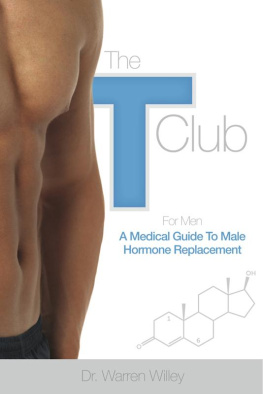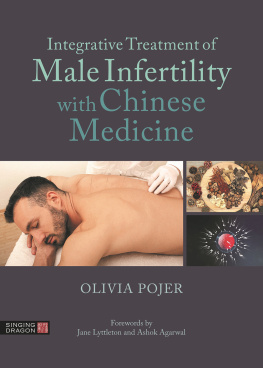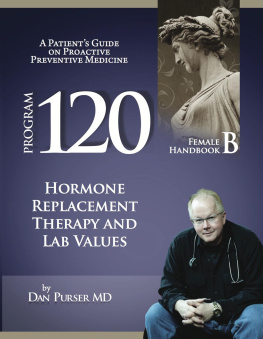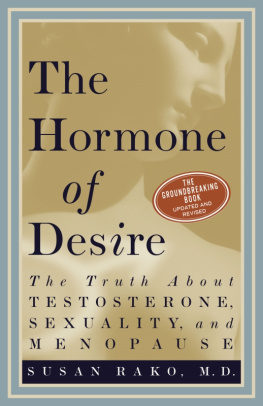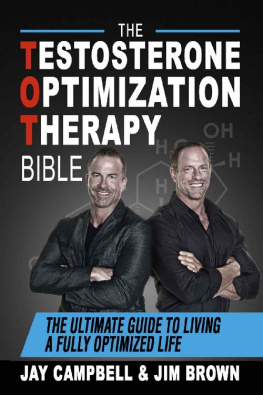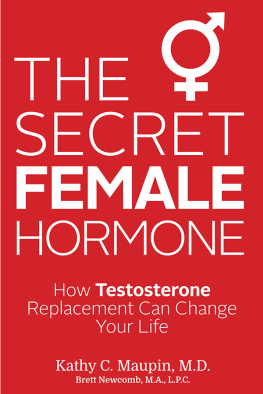

Cover and art by Scott Hollaway of Switch Technologies.
Book layout and design by Danielle Larsen of Larsen Writing and Design, LLC.
Special thanks to my copy editor, Nancy Wall.
The amount of research and article reviews to complete this book would not have been possible without the wonderful assistance and meticulous work of Ashley Moeller. Her future in health care is bound to change the world.
THE T CLUB A STRATIGIC GUIDE TO MALE HORMONE REPLACEMENT
Copyright 2013 by Warren Willey
Published by The Fitness Medicine Clinic, PC
Pocatello, Idaho 83201
ALL RIGHTS RESERVED. No part of this publication may be reproduced, stored in a retrieval system, or transmitted in any form or by any means electronic, mechanical, digital, photocopy, recording, or any other except for brief quotations in printed reviews, without the prior permission of the author.
Printed in the United States of America
ISBN: 9781619273757
TABLE OF CONTENTS
CHAPTER 1:
INTRODUCTION & HISTORY
Introduction
Life cycles are fun to watch. Take, for instance, the birth of a helpless foal: it starts with its mother going into labor, then proceeds to baby struggling to get out of its mothers womb. Once out, exhausted and likely wishing to crawl back in, it lies in a pile of placental fluid and feces. Once it has had a chance to dry, the baby horse clumsily attempts to stand. Finding it was much easier to lie down; it quickly stops trying and falls over. Mother then gently prods baby with her nose, encouraging yet another try. Finally, after what likely seemed forever the foal, winds up standing. The first step is always the one most nerve racking, but with effort and once again mothers encouragement, it is not long before baby is running around the meadow, jumping and kicking, and finally realizing this is much better than being confined in a tight, dark, hidden place where people knew where you were, but thought nothing of it. More experienced horse breeders, trainers, and lovers, could tell the mare was pregnant and growing to eventually give birth, but most people who saw momma horse where none the wiser.
So it is with the life cycle of Testosterone, here on referred to as T, in the medical world. T has been around for a long time but unless you were an athlete or a progressive caring doctor, you only might have been aware of its presence. Hence the horse analogy: we are at the lifecycle of T that involves its running around the fields being both admired and feared at the same time.
Ts history is fascinating but its use for medical replacement has been hindered by a couple of unfortunate misnomers. First and foremost, most doctors, including recent graduates, have been taught that T causes prostate cancer. I will cover this in great detail in coming chapters. Secondly, T is a steroid. The word steroid instantly stirs up discomfort in a majority of people that hear it, as we all think of athletes using performance enhancing drugs. Our minds roll into the unfairness of steroid use, and adjectives such as scary, thoughtless, mysterious, and lazy cross our minds. Cheating, of which no one ever wants to be accused, also comes to the forefront. The word steroid has been linked to bad things. In reality, your body is full of steroids of many different types. The word steroid simply defines its organic shape, but does not imply action or function as the many different steroids in your body do many different things.
I continually have to explain the difference to people when I prescribe different steroids for different reasons. One of my favorite examples of this very common nomenclature error involves a 56- year- old petite, well groomed female who came to me with knee pain. Once my evaluation and examination were done, I offered her a number of therapeutic options, including a steroid shot. As the word steroid rolled off my tongue, her eyes became wider as her eyebrows sprang to the top of her head and her jaw simultaneously dropped. After the gasp that accompanied the facial expression ended and she had reflected for a few seconds on my offer, her response was classic: Doctormy husband will not sleep with me if I have big muscles and a beard like him! Of course, the steroid shot I offered was a corticosteroid shot also referred to as cortisone, a strong anti-inflammatory.
Steroids in general and T in particular cause a visual fallacy to be conjured up when spoken: an assumption is made that if you optimize T you will look like this:

I can guarantee that will not happen especially at the medically approved dosing regimens provided. For that matter, not with super-physiologic doses either! This is probably relieving to some and depressing to others. For those of you who want to look like this, its not likely to happen. You cannot expect, after sitting on your backside for 20 + years, since you were a high school superstar athlete (right Al Bundy?), to look like someone who has been eating right and exercising most days of the week since age 14. Gymnasts are a great example. A childhood gymnast has, since an early age, developed highly sought after abs and shoulders, bulging biceps and sculpted calves. Of course, if they quit exercising altogether and join the ranks of the languid, that desired look will become a thing of the past. But even with the minimal amount of upkeep, they look amazing.
T therapy will make you feel better. You will be stronger, more energetic, more likely to go to the gym, better prepared to say no to the work place donuts, and in general improve your quality of life. It will not, and I repeat WILL NOT make you look like Arnold Schwarzenegger at his prime. That is an Internet filtered lie. Do not be disappointed.
Low T is a deficiency state, and can be described with the simple analogy of oil used in your car after prolonged driving. Yes, it is a natural occurrence to have falling oil pressure in your car after use, but you replace it, do you not? Accepting age related change as natural cannot be considered, as T levels have declined for the whole population over the last 30 years for a number of different reasons which I allude to throughout the book. Total T levels in the 1980s, for 50- year-old men was around 550 ng/dl; In the mid- 1990s it dropped to the 475 ng/dl range, and in the early 2000s the average 50- year- old man had total T levels of 440 ng/dl.
I am absolutely certain that if T did not have a surname of steroid and if doctors understood the prostate and Ts effects on its growth and cancer, T would be as common a prescription as estrogen is in female hormone replacement.
T is a controlled substance, as you will learn a little more about in the portion on the history of T. Therefore, it must be provided to you by your doctor on the appropriate prescription paper, and with a limited number of refills per your local state board of pharmacy. In the drug reference section of all the different TRT delivery systems, under Drug Abuse and Dependence the only thing listed is Testosterone is classified as a Schedule III controlled substance under the Anabolic Steroids Act of 1990. There is no mention of abuse or dependence. Can T be abused? Of course so can pizza. T is not addictive under the standard definitions of addiction. For a drug to cause dependence it must be craved, binging must occur, withdrawal to its effects has to be present, and the drug must have cross-sensitization with other drugs. T may be sought after, but not craved. Some may binge on it, but thats very unlikely. There is no physiologic withdrawal from T. You may not feel your best as you revert back to your low T levels, if you stop using it without your doctors help, but you will not have a seizure.
Next page
